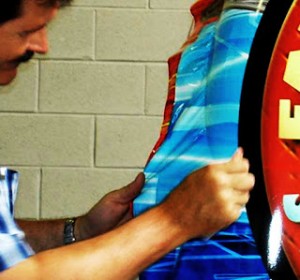To avoid problems with vinyl or any other pressure-sensitive material, carefully read the vinyl manufacturer’s technical data sheet. Product bulletins will usually contain all of the information you need, including application temperature range. The application temperature range for most vinyl films is usually between 50⁰ and 90⁰F (10⁰ to 32⁰ C). For some films, the minimum application temperature range is higher.
As the adhesive continues to flow naturally into the microscopic pores, ultimate adhesion increases. Rising temperatures accelerate this process; predictably, colder temperatures retard the process.
At room temperature, the adhesive of a pressure-sensitive material, such as RTape VinylEfx®, starts to wet out, after pressure is applied. (Remember: it is called pressure-sensitive for a reason. You typically need pressure for the graphic to stick to the substrate.) Room-temperature application serves as the ideal environment because the temperature in a sign shop is typically in the range of 65⁰ to 74⁰F (18⁰ to 23⁰C). The temperature in a garage is a totally different story. And when you have to do an outdoor application, you are at the mercy of Mother Nature.
Vehicle graphics applications in the dead of winter are challenging. Sometimes impossible! Tractors and trailers should be washed the day prior to installation. Ideally, the unit should be pulled indoors the night before to sufficiently heat it. This step is absolutely critical if you’re installing graphics on heavy construction equipment, when temperatures are sub-zero. It can take days for such equipment to reach an adequate installation temperature.
In the real world, however, fleets are often left outdoors until the time for graphics application. Snow and ice that have accumulated on the equipment should be removed before the units are pulled indoors. This prevents water dripping on you and your work as the vehicle defrosts. If water has accumulated on the trailer’s roof, lower the vehicle’s landing gear at the front of the trailer. This creates a slope on the roof, speeding water runoff.
Once indoors, open all the unit’s doors to release cold air. Directing portable heaters inside will speed the warming process. Portable heaters can make graphic applications possible, even when the installation facility is inadequately heated. Remember that the application temperature refers to the substrate’s temperature, not the ambient air temperature.
Some vinyl films, but not all, can be installed at temperatures as low as 40°F (4⁰C). By misting the adhesive with isopropyl alcohol, you may gain 10°F (6⁰C) of application temperature. At lower temperatures, the best advice is to go home, throw a log on the fire and wait for a warmer day.
Hot-weather installations can be much more difficult than cold conditions. As the temperature rises, the tack, or stickiness, of the adhesive increases. Sometimes, pressure-sensitive vinyl sticks without pressure, resulting in graphic deformation, when you attempt to reposition the graphic. When this happens, the term used (other than the litany of expletives that the frustrated and angry installer utters) is “pre-adhesion” or “pre-tack”.
We can’t change the weather, but we can improve installation conditions. Opening vehicle doors allows heat to escape. Scheduling an installation for an evening or an early morning — or simply waiting for the position of the sun to change — can help you beat the heat.
For hot weather applications on smooth surfaces, try misting the surface with a garden hose. This cooling effect can reduce the surface temperature and the adhesive tack to allow for repositioning. Application fluid is also an option. While both techniques work usually work well on smooth, flat surfaces, they’re not recommended for rivet applications and not recommended when applying metalized films, such as reflectives or VinylEfx®.




